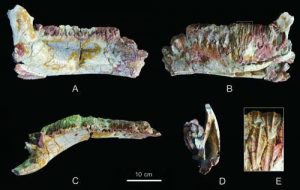
The origin of hadrosaurid dinosaurs is far from clear, mainly due to the paucity of their early Late Cretaceous close relatives. Compared to numerous Early Cretaceous basal hadrosauroids, which are mainly from Eastern Asia, only six early Late Cretaceous basal hadrosauroids have been found: three from Asia and three from North America. In a study published online October 18 in PLoS ONE 8(10), Dr. YOU Hailu, Institute of Vertebrate Paleontology and Paleoanthropology, Chinese Academy of Sciences (IVPP), and his collaborators from Shanxi Museum of Geological and Mineral Science and Technology, Shanxi Province of China described a new hadrosauroid dinosaur, Yunganglong datongensis gen. et sp. nov., from the early Late Cretaceous Zhumapu Formation of Shanxi Province in northern China. This find adds another record of basal Hadrosauroidea in the early Late Cretaceous, and helps to elucidate the origin and evolution of Hadrosauridae.
The new taxon is represented by an associated but disarticulated partial adult skeleton, including the caudodorsal part of the skull, two cervical vertebrae, partial dorsal neural arch and neural processes, two caudals, distal portions of both ischia, distal end of left femur, proximal portion of right tibia, and distal portion of left tibia with astragalus.
Hadrosauroids were facultative bipedal dinosaurs that dominated Cretaceous Laurasian megaherbivorous niches. During the Late Cretaceous, they gave rise to hadrosaurid dinosaurs, which are characterized by duck-like bills and complex grinding dentitions that rival those of horses and bovids.
Cladistic analysis and comparative studies show that Yunganglong represents one of the most basal Late Cretaceous hadrosauroids and is diagnosed by a unique combination of features in its skull and femur.
“Basal hadrosauroids are mainly known from the Early Cretaceous of Eastern Asia, and especially northern China. Therefore, the discovery of new early Late Cretaceous basal hadrosauroids has important phylogenetic and paleobiogeographical significance and can help elucidate the evolution of hadrosauroids, especially the origin of hadrosaurids”, said Dr. YOU Hailu, corresponding author of the study.
This study was supported by the National Natural Science Foundation of China, the Hundred Talents Project of the Chinese Academy of Sciences, and the Department of Land and Resources of Shanxi Province.


Reference:
A new hadrosauroid dinosaur from the Late Cretaceous of Tianzhen, Shanxi Province, China. DOI:10.1371/journal.pone.0077058
Note: The above post is reprinted from materials provided by Chinese Academy of Sciences.










